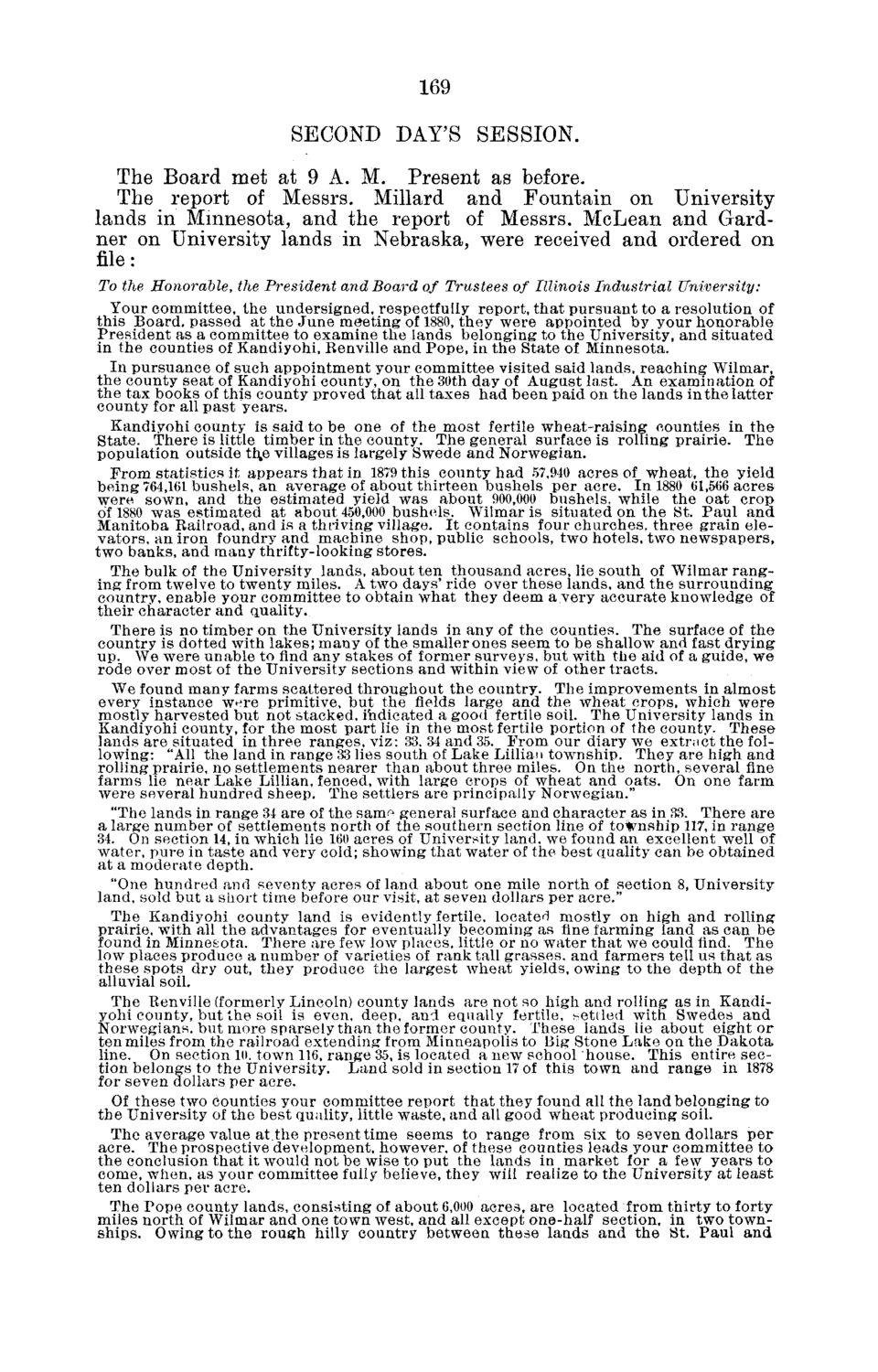| |
| |
Caption: Board of Trustees Minutes - 1882
This is a reduced-resolution page image for fast online browsing.

EXTRACTED TEXT FROM PAGE:
169 SECOND DAY'S SESSION. The Board met at 9 A. M. Present as before. The report of Messrs. Millard and Fountain on University lands in Minnesota, and the report of Messrs. McLean and Gardner on University lands in Nebraska, were received and ordered on file: To the Honorable, the President and Board of Trustees of Illinois Industrial University: Your committee, the undersigned, respectfully report, that pursuant to a resolution of this Board, passed at the June meeting of 1880, they were appointed by your honorable President as a committee to examine the lands belonging to the University, and situated in the counties of Kandiyohi, Renville and Pope, in the State of Minnesota. In pursuance of such appointment your committee visited said lands, reaching Wilmar, the county seat of Kandiyohi county, on the 30th day of August last. An examination of the tax books of this county proved that all taxes had been paid on the lauds in the latter county for all past years. Kandiyohi county is said to be one of the most fertile wheat-raising counties in the State. There is little timber in the county. The general surface is rolling prairie. The population outside tl\e villages is largely Swede and Norwegian. From statistics it appears that in 1879 this county had 57,940 acres of wheat, the yield being 764,161 bushels, an average of about thirteen bushels per acre. In 1880 61,566 acres were sown, and the estimated yield was about 900,000 bushels, while the oat crop of 1880 was estimated at about 450,000 bushels. Wilmar is situated on the St. Paul and Manitoba Railroad, and is a thriving village. It contains four churches, three grain elevators, an iron foundry and machine shop, public schools, two hotels, two newspapers, two banks, and many thrifty-looking stores. The bulk of the University lands, about ten thousand acres, lie south of Wilmar ranging from twelve to twenty miles. A two days' ride over these lands, and the surrounding country, enable your committee to obtain what they deem a very accurate knowledge of their character and quality. There is no timber on the University lands in any of the counties. The surface of the country is dotted with lakes; many of the smaller ones seem to be shallow and fast drying up. We were unable to find any stakes of former surveys, but with the aid of a guide, we rode over most of the University sections and within view of other tracts. We found many farms scattered throughout the country. The improvements in almost every instance were primitive, but the fields large and the wheat crops, which were mostly harvested but not stacked, indicated a good fertile soil. The University lands in Kandiyohi county, for the most part lie in the most fertile portion of the county. These lands are situated in three ranges, viz: 33, 34 and 35. From our diary we extract the following: "All the land in range 33 lies south of Lake Lillian township. They are high and rolling prairie, no settlements nearer than about three miles. On the north, several fine farms lie near Lake Lillian, fenced, with large crops of wheat and oats. On one farm were several hundred sheep. The settlers are principally Norwegian." "The lands in range 34 are of the sam« general surface and character as in 33. There are a large number of settlements north of the southern section line of township 117, in range 34. On section 14, in which lie 160 acres of University land, we found an excellent well of water, pure in taste and very cold; showing that water of the best quality can be obtained at a moderate depth. "One hundred and seventy acres of land about one mile north of section 8, University land, sold but a short time before our visit, at seven dollars per acre." The Kandiyohi county land is evidently fertile, located mostly on high and rolling prairie, with all the advantages for eventually becoming as fine farming land as can be found in Minnesota. There are few low places, little or no water that we could find. The low places produce a number of varieties of rank tall grasses, and farmers tell us that as these spots dry out, they produce the largest wheat yields, owing to the depth of the alluvial soil. The Renville (formerly Lincoln) county lands are not so high and rolling as in Kandiyohi county, but the soil is even, deep, and equally fertile, settled with Swedes and Norwegians, but more sparsely than the former county. These lands lie about eight or ten miles from the railroad extending from Minneapolis to Big Stone Lake on the Dakota line. On section 10. town 116, range 35, is located a new school house. This entire section belongs to the University. Land sold in section 17 of this town and range in 1878 for seven dollars per acre. Of these two counties your committee report that they found all the land belonging to the University of the best quality, little waste, and all good wheat producing soil. The average value at.the present time seems to range from six to seven dollars per acre. The prospective development, however, of these counties leads your committee to the conclusion that it would not be wise to put the lands in market for a few years to come, when, as your committee fully believe, they will realize to the University at least ten dollars per acre. The Pope county lands, consisting of about 6,000 acres, are located from thirty to forty miles north of Wilmar and one town west, and all except one-half section, in two townships. Owing to the rough hilly country between these lands and the St. Paul and
| |